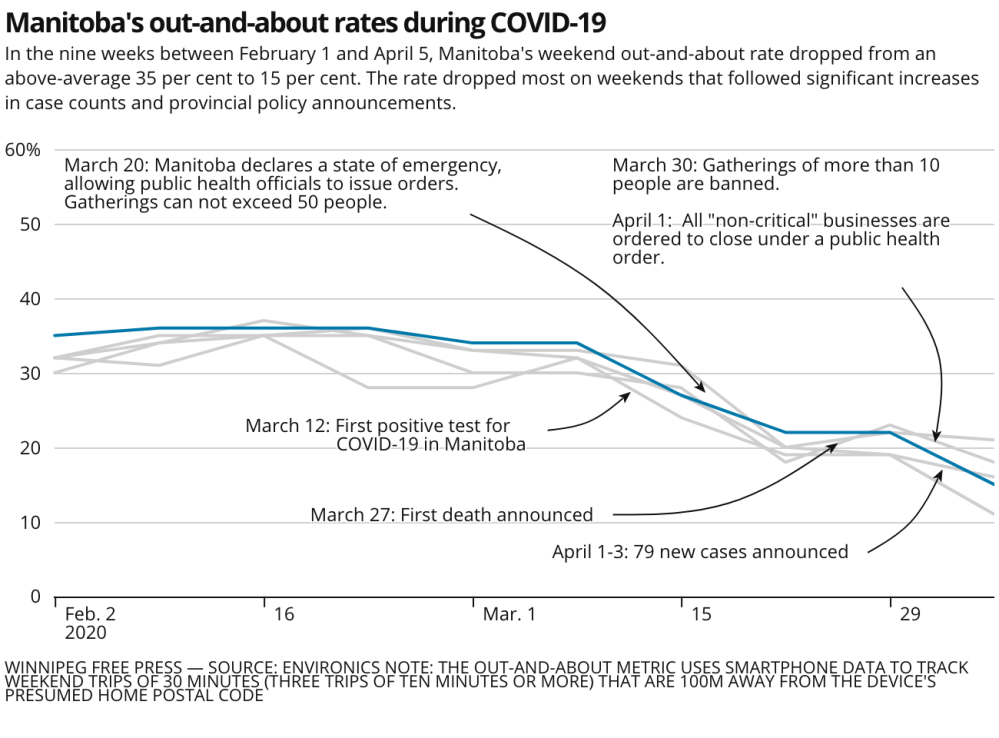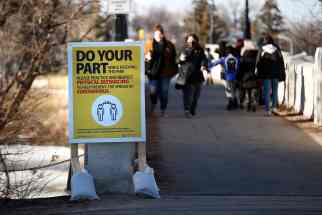Neighbourhoods watched: social-distancing adherence varies across the city
Read this article for free:
or
Already have an account? Log in here »
To continue reading, please subscribe:
Monthly Digital Subscription
$0 for the first 4 weeks*
- Enjoy unlimited reading on winnipegfreepress.com
- Read the E-Edition, our digital replica newspaper
- Access News Break, our award-winning app
- Play interactive puzzles
*No charge for 4 weeks then price increases to the regular rate of $19.00 plus GST every four weeks. Offer available to new and qualified returning subscribers only. Cancel any time.
Monthly Digital Subscription
$4.75/week*
- Enjoy unlimited reading on winnipegfreepress.com
- Read the E-Edition, our digital replica newspaper
- Access News Break, our award-winning app
- Play interactive puzzles
*Billed as $19 plus GST every four weeks. Cancel any time.
To continue reading, please subscribe:
Add Free Press access to your Brandon Sun subscription for only an additional
$1 for the first 4 weeks*
*Your next subscription payment will increase by $1.00 and you will be charged $16.99 plus GST for four weeks. After four weeks, your payment will increase to $23.99 plus GST every four weeks.
Read unlimited articles for free today:
or
Already have an account? Log in here »
Hey there, time traveller!
This article was published 14/04/2020 (2065 days ago), so information in it may no longer be current.
As the first cases of the novel coronavirus were reported in Manitoba, and public health officials began stating the need to adhere to strict social distancing guidelines, the extent to which Winnipeggers stayed close to home varied from neighbourhood to neighbourhood.
The province announced the first positive case of COVID-19 on Thursday, March 12. That weekend, the number of Winnipeggers “out-and-about” throughout the city began to tumble.
The out-and-about rate is calculated by Toronto-firm Environics Analytics by looking at the number of people spending more than 30 minutes away from their home area during a weekend day. The company uses cellphone location data from apps to track movements.
On that weekend, roughly 20 to 25 per cent of residents throughout a patchwork of areas in Winnipeg ventured more than 100 metres from their neighbourhoods for extended periods of time.
East Elmwood, Chalmers and Kildonan Crossing were notable exceptions, with slightly more than 30 per cent of residents heading out on the weekend.
By the next weekend, as case counts began to rise and public health orders went into effect, behaviour in the city shifted. In most neighbourhoods, fewer than 20 per cent of residents were out-and-about.
A few neighbourhoods, including Grant Park, South Portage and Glenelm, dipped below 15 per cent. But again there were exceptions: in the University and Fort Richmond area, the rate was 26.8 per cent.
Follow 10 weeks of Winnipeg’s out-and-about rate during the COVID-19 pandemic
Environics Analytics uses anonymized cellphone location data to track device movement over time. The out-and-about rate is a measure of three weekend daytime excursions, each lasting 10 minutes or longer, that are 100 metres or more from the device’s home postal code.
Early February’s baseline, with some areas of the city in the 30-50 per cent range, plummets as COVID-19 case counts and official measures take hold. Ten weeks later, on the weekend of April 5, Winnipeg’s rate was in the low to mid-teens across most city neighbourhoods.

Animated gif will advance after 2 seconds.
Elaine Power, a food security expert and professor at Queen’s University in Kingston, Ont., said there are myriad ways people’s socio-economic backgrounds could impact their movement patterns during the pandemic.
“The people we’ve come to see as essential workers are people who still have to go out. You may have, in lower income neighbourhoods, more grocery store workers, more bus drivers. The people who are still keeping things moving,” Power said.
“Those of us with higher incomes and white-collar jobs, we can work from home. That’s harder with a blue-collar job… Also, some people don’t have the money to stock up and hoard things, they don’t have the money or the space, so it’s likely they would have to go out more often for food.”
Power said people with larger houses or access to backyards, as opposed to those living in apartments or multi-family dwellings, may be less likely to feel the need to go on extended walks, which would further cut down the amount of time spent away from home.
In Winnipeg, the beginning of spring, which included a few days of temperatures above zero, was marked by a brief return to out-and-about rates in the low 20s in most neighbourhoods north of the Assiniboine and east of the Red River.
However, residents in Spence, Central Park and Garden City appear to have heeded the stay-at-home order, with rates staying at, or below, 15 per cent.
By the first weekend of April, four days after the provincial government declared a state of emergency, the out-and-about rate was pushed down even further.
Meanwhile, Andrew Enns, executive vice-president of Leger, a market research and analytics company, said recent polling suggests 31 per cent of Manitobans have ignored at least one recommended social distancing guideline — five percentage points above the national average.
In Canada, men and young adults aged 18 to 24 are most likely to flout protective measures.
But while the number of Manitobans not following all social distancing directives is higher than the cross-country average, so too is the number of people willing to report others for the behaviour.
Throughout the country, 40 per cent of people said they would snitch on someone for not practising good social distancing. In Manitoba, that figure sits at 45 per cent.
“We’re managing our infections and the deaths, so it doesn’t give a sense things are out-of-control here. The concern among residents of Manitoba seems to be a little less acute than what you see in some other provinces, like Ontario or Quebec, for example,” Enns said.
“I think Manitoba has been doing fairly well. I wouldn’t say we’re at the forefront of things, but nor are we near the back of the pack.”
ryan.thorpe@freepress.mb.ca
Twitter: @rk_thorpe
michael.pereira@freepress.mb.ca
Twitter: @_m_pereira

Ryan Thorpe likes the pace of daily news, the feeling of a broadsheet in his hands and the stress of never-ending deadlines hanging over his head.
Our newsroom depends on a growing audience of readers to power our journalism. If you are not a paid reader, please consider becoming a subscriber.
Our newsroom depends on its audience of readers to power our journalism. Thank you for your support.







